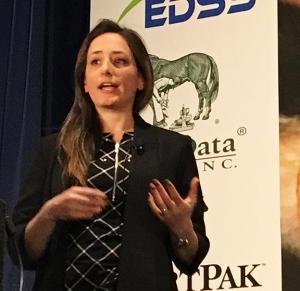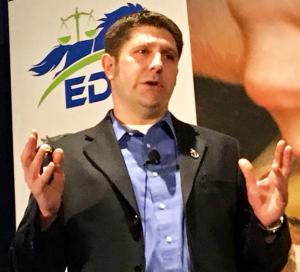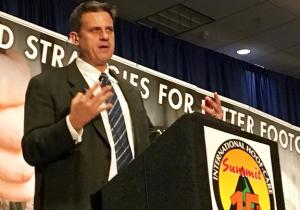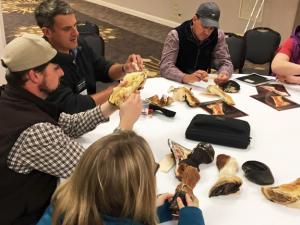Compiled by Nancy Brannon
The theme of the 15th anniversary International Hoof-Care Summit was “Sound Strategies For Better Foot Care.” Held in Cincinnati, Ohio, January 23-26, 2018, the conference offered 8 General Sessions, 15 Hoof-Care Classrooms, 24 Hoof-Care Roundtables, 12 “How-To” Clinics and many hours to discover 2018’s newest footcare products at the IHCS Trade Show.
The American Farriers Journal-sponsored event lined up nearly 40 top-notch farriers, veterinarians, and researchers to deliver innovative ideas to help farriers increase their hoof-care knowledge and increase their business. Members of the American, Canadian and International Associations of Professional Farriers who attend the entire International Hoof-Care Summit could earn 27 credit hours. And the Ohio State Veterinary Medical Licensing Board approved the 2018 Summit for 30 continuing education credit hours for veterinarians and vet techs.
Following is a sampling of some of the educational sessions at the IHCS.
Paige Poss, of Tuscon, Arizona, surveyed the anatomy of bone structure in the horse, from foal to maturity. A foal’s bones are still developing in the early months of the horse’s life, and Poss discussed the specific differences between the immature and the mature foot. She surveyed the anatomy of these structures and discussed how the immature bone responds and adapts as it grows to maturity.
Stuart Muir of Rood & Riddle Equine Hospital in Lexington, KY covered shoeing options in relation to growth plate assessment. Muir covered common and not-so-common issues including flexural deformities and treatment of club-footed foals.
Topics in some of the “how to” hoof care product knowledge clinics included:
· Shiny, glossy hair coat, but crappy feet: what’s missing?
· Practical advice for using pour-in pads.
· Helping clients select a hoof supplement.
· Dealing with the heels during the shoeing cycle.
· Managing the club-footed horse.
· Breakover: what is it and what does moving it affect?
· Trends that affect show hunters/jumpers are shod.
· Tackling hoof wall separations.
· Veterinarian-farrier relationships: the middle ground of overlapping practices.
· And a few lessons from more than 50 years as a farrier.
Italian farrier Dominico Cellaro created his own system for hoof measurement. His findings help further understanding of how horseshoes affect the different gaits in relation to ground reaction forces.
Dr. Andrew van Eps of the University of Pennsylvania addressed how conditions like obesity or contra-lateral leg lameness can lead to laminitis. He presented options for managing the acute or chronic laminitic horse, giving general management and basic medical strategies, as well as shoeing and orthotics.
Travis Burns, of the Virginia-Maryland Regional College of Veterinary Medicine, explained the cause and effect of white line disease, showing what is truly being damaged. He shared tips for successful treatment, including debridement, shoeing options, and aftercare.
Lexington, Kentucky farrier Bobby Menker has shod all kinds of performance horses in both English and western disciplines since 1979. He surveyed a variety of his cases to show what should be considered for better traction, depending on surface material.
Cornell University farrier Steve Kraus explained how poor fitting saddles can cause not only discomfort, but also lameness, gait faults, shoeing problems, and even personality problems. He explained how to recognize such problems, and how appropriate, skillful farriery can work in concert with saddler and other equine care issues.
Staffordshire, England farrier Jonathan Nunn has researched how the P3 bone angle dictates hoof wall angle. He investigated the variation of angles of P3 to test the hypothesis of angular similarity of bone morphology to hoof wall angle.
Dr. Scott Pleasant of the Virginia-Maryland College of Veterinary Medicine discussed the use of radiographs in shoe placement and how the farrier can use and interpret radiographic to ascertain what happens to the hoof pre- and post-shoeing.
Dr. Patricia Bona discussed equine chiropractic care in relation to evaluating the difference between posture and conformation. She discussed how scar tissue and old injuries are often the cause of poor posture and irregular biomechanics, as related to hoof care and balance. For examples, mutton withers, ewe neck, and a tight throat latch are signs of poor posture, not poor conformation.
Royal Veterinary College researcher Amy Barstow has been investigating the effect of modern shoeing materials on foot-surface impact shock in horses. It is thought that high levels of impact shock, and the subsequent high frequency vibrations that occur during foot-surface impact, can be related to joint pathology and lameness. Although there has been a lot of work to develop riding surfaces that can reduce high levels of impact shock, not all horses have access to these surfaces. Barstow summarized the results of her three years’ research on impact-shock reduction.
Ashland, Ohio farrier Randy Luikart has decades of experience shoeing the American Saddlebred. He explained management of the longer hoof, by positional alignment of the hoof with the three axis of the limb using arc support mechanics and visual weight bearing evaluation.
Luikaft also gave the IHCS 15th anniversary lecture: “A Review of Equine Movement.” He reviewed several topics associated with equine biomechanics, including how the horse’s movement requires the foot and leg to operate mechanically in two roles – load acceptance, and load application, using physics to give a clearer picture of equine motion.
Farrier Mary Bramley, formerly an attorney, explained how to classify farrier businesses. She discussed the advantages and disadvantages of a limited liability company and other business structures.
Australian muscle therapist Gary Wells presented a specifically designed muscle/horse therapy course for farriers. The course deliveres two human muscle adjustments specifically designed to release the arms, neck, shoulders, and back of the farrier. He also presented a clinical assessment of fetlock and hoof torques to provide an equibrium of forces on the distal limb for weight bearing and swing phase function.
Marblehead, Ohio farrier and veterinarian Adam Pendleton addressed hoof wall distortions in relation to quarter cracks. He reviewed how some common approaches don’t actually fix the problem, and shared his guidelines for management of quarter cracks and associated pain.
Tim Cable, Bladsell, NY farrier, shared insights on horsemanship from his multi-generational farrier family and honed from his work across several disciplines.
Find more information about the IHCS at https://www.americanfarriers.com/ihcs. Find more about the daily activities on facebook at: American Farriers Journal.
Next year’s 16th annual summit will be held January 22-25, 2019 in Cincinnati, Ohio.
The theme of the 15th anniversary International Hoof-Care Summit was “Sound Strategies For Better Foot Care.” Held in Cincinnati, Ohio, January 23-26, 2018, the conference offered 8 General Sessions, 15 Hoof-Care Classrooms, 24 Hoof-Care Roundtables, 12 “How-To” Clinics and many hours to discover 2018’s newest footcare products at the IHCS Trade Show.
The American Farriers Journal-sponsored event lined up nearly 40 top-notch farriers, veterinarians, and researchers to deliver innovative ideas to help farriers increase their hoof-care knowledge and increase their business. Members of the American, Canadian and International Associations of Professional Farriers who attend the entire International Hoof-Care Summit could earn 27 credit hours. And the Ohio State Veterinary Medical Licensing Board approved the 2018 Summit for 30 continuing education credit hours for veterinarians and vet techs.
Following is a sampling of some of the educational sessions at the IHCS.
Paige Poss, of Tuscon, Arizona, surveyed the anatomy of bone structure in the horse, from foal to maturity. A foal’s bones are still developing in the early months of the horse’s life, and Poss discussed the specific differences between the immature and the mature foot. She surveyed the anatomy of these structures and discussed how the immature bone responds and adapts as it grows to maturity.
Stuart Muir of Rood & Riddle Equine Hospital in Lexington, KY covered shoeing options in relation to growth plate assessment. Muir covered common and not-so-common issues including flexural deformities and treatment of club-footed foals.
Topics in some of the “how to” hoof care product knowledge clinics included:
· Shiny, glossy hair coat, but crappy feet: what’s missing?
· Practical advice for using pour-in pads.
· Helping clients select a hoof supplement.
· Dealing with the heels during the shoeing cycle.
· Managing the club-footed horse.
· Breakover: what is it and what does moving it affect?
· Trends that affect show hunters/jumpers are shod.
· Tackling hoof wall separations.
· Veterinarian-farrier relationships: the middle ground of overlapping practices.
· And a few lessons from more than 50 years as a farrier.
Italian farrier Dominico Cellaro created his own system for hoof measurement. His findings help further understanding of how horseshoes affect the different gaits in relation to ground reaction forces.
Dr. Andrew van Eps of the University of Pennsylvania addressed how conditions like obesity or contra-lateral leg lameness can lead to laminitis. He presented options for managing the acute or chronic laminitic horse, giving general management and basic medical strategies, as well as shoeing and orthotics.
Travis Burns, of the Virginia-Maryland Regional College of Veterinary Medicine, explained the cause and effect of white line disease, showing what is truly being damaged. He shared tips for successful treatment, including debridement, shoeing options, and aftercare.
Lexington, Kentucky farrier Bobby Menker has shod all kinds of performance horses in both English and western disciplines since 1979. He surveyed a variety of his cases to show what should be considered for better traction, depending on surface material.
Cornell University farrier Steve Kraus explained how poor fitting saddles can cause not only discomfort, but also lameness, gait faults, shoeing problems, and even personality problems. He explained how to recognize such problems, and how appropriate, skillful farriery can work in concert with saddler and other equine care issues.
Staffordshire, England farrier Jonathan Nunn has researched how the P3 bone angle dictates hoof wall angle. He investigated the variation of angles of P3 to test the hypothesis of angular similarity of bone morphology to hoof wall angle.
Dr. Scott Pleasant of the Virginia-Maryland College of Veterinary Medicine discussed the use of radiographs in shoe placement and how the farrier can use and interpret radiographic to ascertain what happens to the hoof pre- and post-shoeing.
Dr. Patricia Bona discussed equine chiropractic care in relation to evaluating the difference between posture and conformation. She discussed how scar tissue and old injuries are often the cause of poor posture and irregular biomechanics, as related to hoof care and balance. For examples, mutton withers, ewe neck, and a tight throat latch are signs of poor posture, not poor conformation.
Royal Veterinary College researcher Amy Barstow has been investigating the effect of modern shoeing materials on foot-surface impact shock in horses. It is thought that high levels of impact shock, and the subsequent high frequency vibrations that occur during foot-surface impact, can be related to joint pathology and lameness. Although there has been a lot of work to develop riding surfaces that can reduce high levels of impact shock, not all horses have access to these surfaces. Barstow summarized the results of her three years’ research on impact-shock reduction.
Ashland, Ohio farrier Randy Luikart has decades of experience shoeing the American Saddlebred. He explained management of the longer hoof, by positional alignment of the hoof with the three axis of the limb using arc support mechanics and visual weight bearing evaluation.
Luikaft also gave the IHCS 15th anniversary lecture: “A Review of Equine Movement.” He reviewed several topics associated with equine biomechanics, including how the horse’s movement requires the foot and leg to operate mechanically in two roles – load acceptance, and load application, using physics to give a clearer picture of equine motion.
Farrier Mary Bramley, formerly an attorney, explained how to classify farrier businesses. She discussed the advantages and disadvantages of a limited liability company and other business structures.
Australian muscle therapist Gary Wells presented a specifically designed muscle/horse therapy course for farriers. The course deliveres two human muscle adjustments specifically designed to release the arms, neck, shoulders, and back of the farrier. He also presented a clinical assessment of fetlock and hoof torques to provide an equibrium of forces on the distal limb for weight bearing and swing phase function.
Marblehead, Ohio farrier and veterinarian Adam Pendleton addressed hoof wall distortions in relation to quarter cracks. He reviewed how some common approaches don’t actually fix the problem, and shared his guidelines for management of quarter cracks and associated pain.
Tim Cable, Bladsell, NY farrier, shared insights on horsemanship from his multi-generational farrier family and honed from his work across several disciplines.
Find more information about the IHCS at https://www.americanfarriers.com/ihcs. Find more about the daily activities on facebook at: American Farriers Journal.
Next year’s 16th annual summit will be held January 22-25, 2019 in Cincinnati, Ohio.










